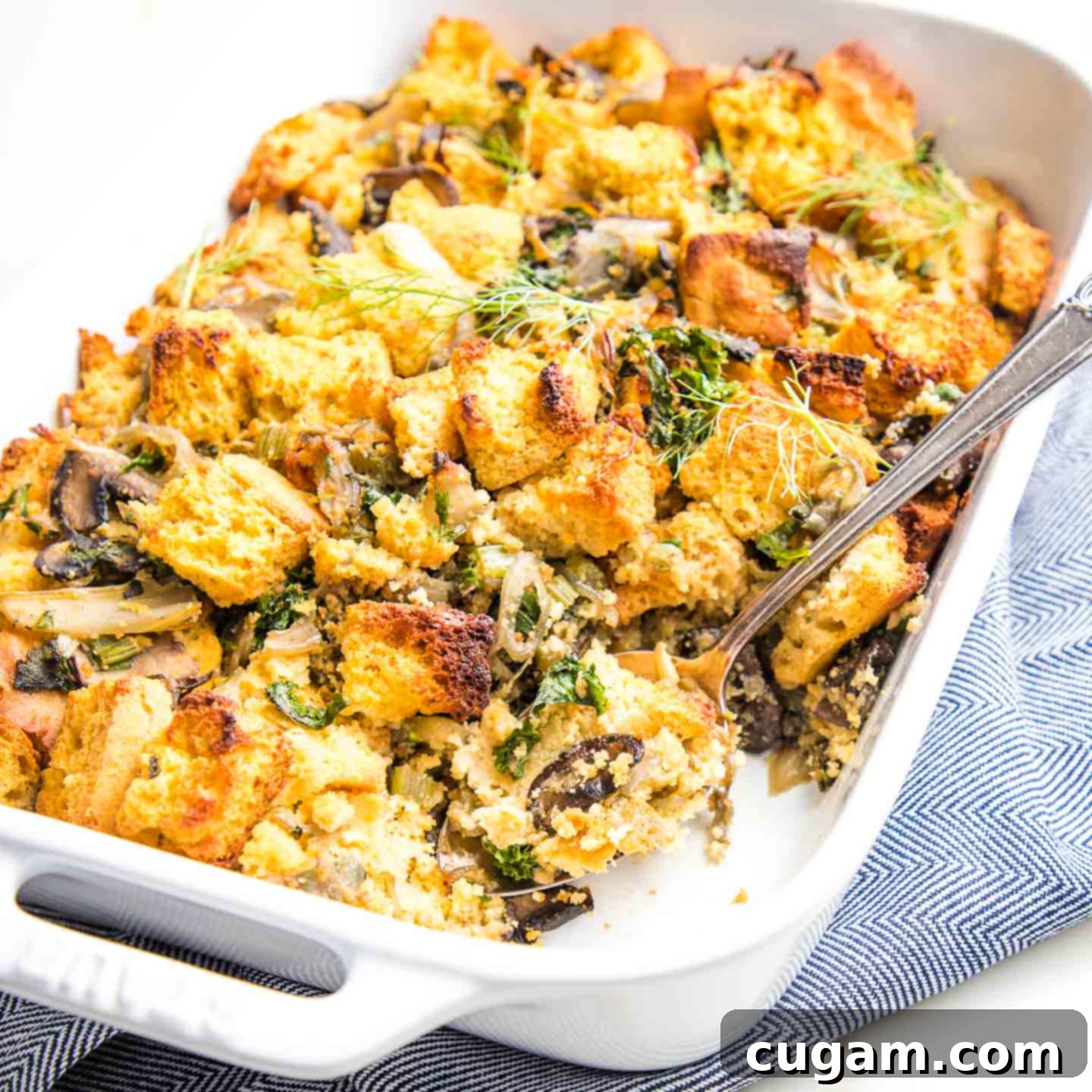The Ultimate Gluten-Free Vegan Cornbread Stuffing: A Thanksgiving Must-Have Recipe
Thanksgiving tables are incomplete without a hearty, flavorful stuffing. This year, ensure everyone at your gathering can indulge in this beloved classic by preparing a sensational gluten-free cornbread stuffing that’s also completely vegan. Our recipe delivers the perfect balance of salty, savory, sweet, and herby notes, creating a uniquely moist and deeply flavorful stuffing. Imagine a dish that’s wonderfully soft on the inside yet boasts a delightfully crispy, golden-brown top – truly the best of both worlds. This is not just any side dish; it’s a centerpiece that caters to diverse dietary needs without compromising on taste or texture, making it a true Thanksgiving must-have.
What makes this particular stuffing recipe so exceptional? It masterfully blends savory and subtly sweet flavors, enhanced by a rich vegan umami that will surprise and delight your taste buds. The secret to its incredible foundation lies in using high-quality cornbread. For those requiring a gluten-free option, I highly recommend my homemade gluten-free cornbread recipe. It’s ideal for making ahead and freezing, simplifying your holiday prep. While my vegan skillet cornbread is also fantastic, please note it is not gluten-free, so choose accordingly based on your guests’ dietary needs. Using homemade cornbread allows for superior flavor and texture control, setting the stage for an unforgettable stuffing experience.
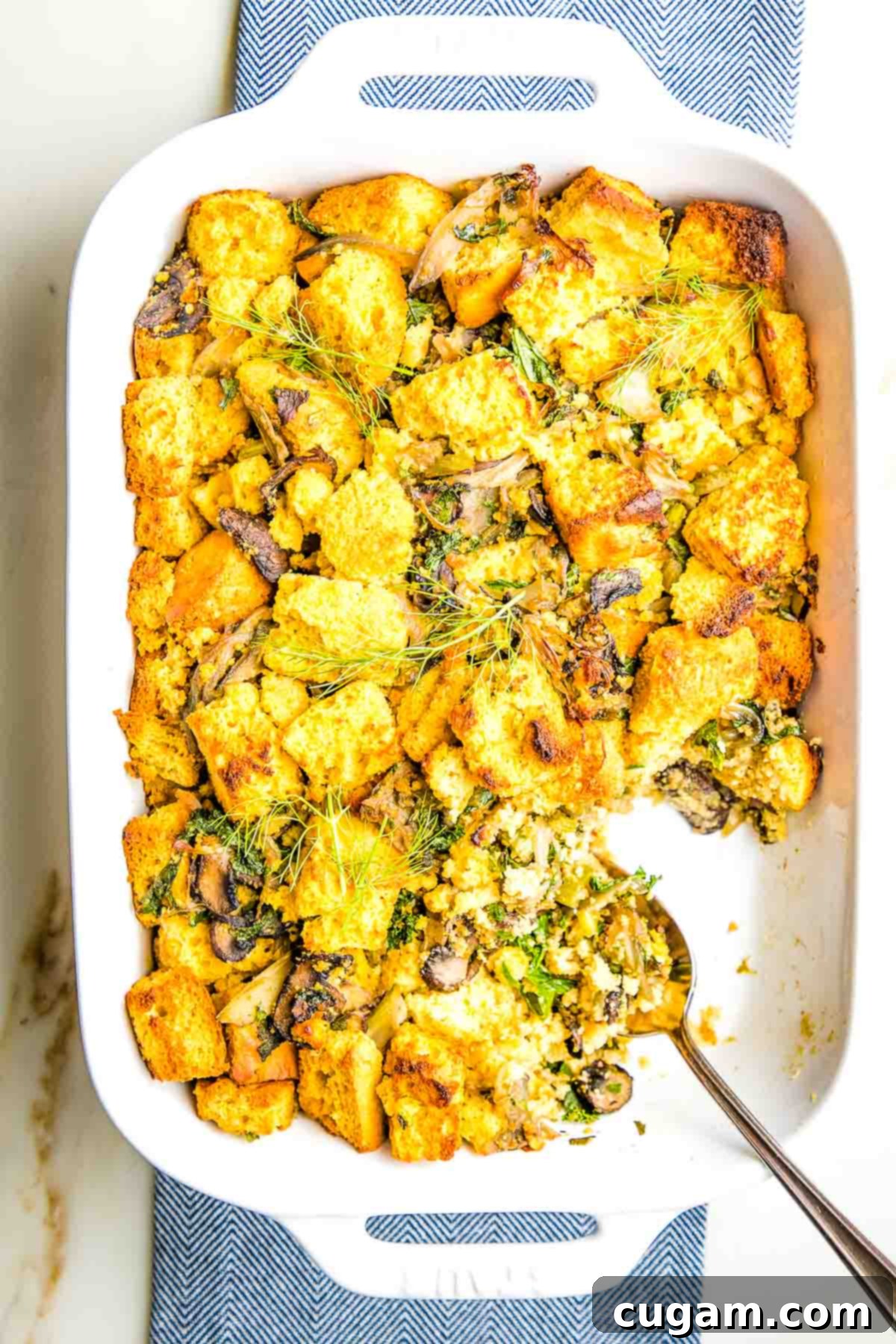
This post has been updated from the original posted November 18, 2020.
For many, stuffing is the quintessential Thanksgiving side dish, evoking warmth and comfort. I must admit, I wasn’t always its biggest advocate, but this particular gluten-free vegan cornbread stuffing recipe has completely transformed my perspective. It’s more than just a side; it’s a culinary revelation.
While the traditional stuffing foundation of aromatic onion, crisp celery, and earthy sage remains, I’ve elevated this recipe with a thoughtful selection of additional vegetables. The inclusion of meaty mushrooms, vibrant kale, and subtly sweet fennel doesn’t just add incredible flavor and texture; it also provides a welcome boost of nutrition. This abundance of fresh produce creates a well-rounded and balanced dish that truly earns its prime spot on any Thanksgiving buffet, proving that healthy can be utterly delicious.
Key Ingredients & Thoughtful Substitutions for Your Cornbread Stuffing
The magic of this vegan cornbread stuffing lies in its vibrant array of fresh ingredients. Before you begin the cooking process, take the time to gather and prep all your vegetables. This mise en place will ensure a smooth and enjoyable cooking experience. Each component plays a vital role, contributing to the stuffing’s wonderful earthy, rustic, and deeply savory flavor profile that will make your Thanksgiving meal shine.
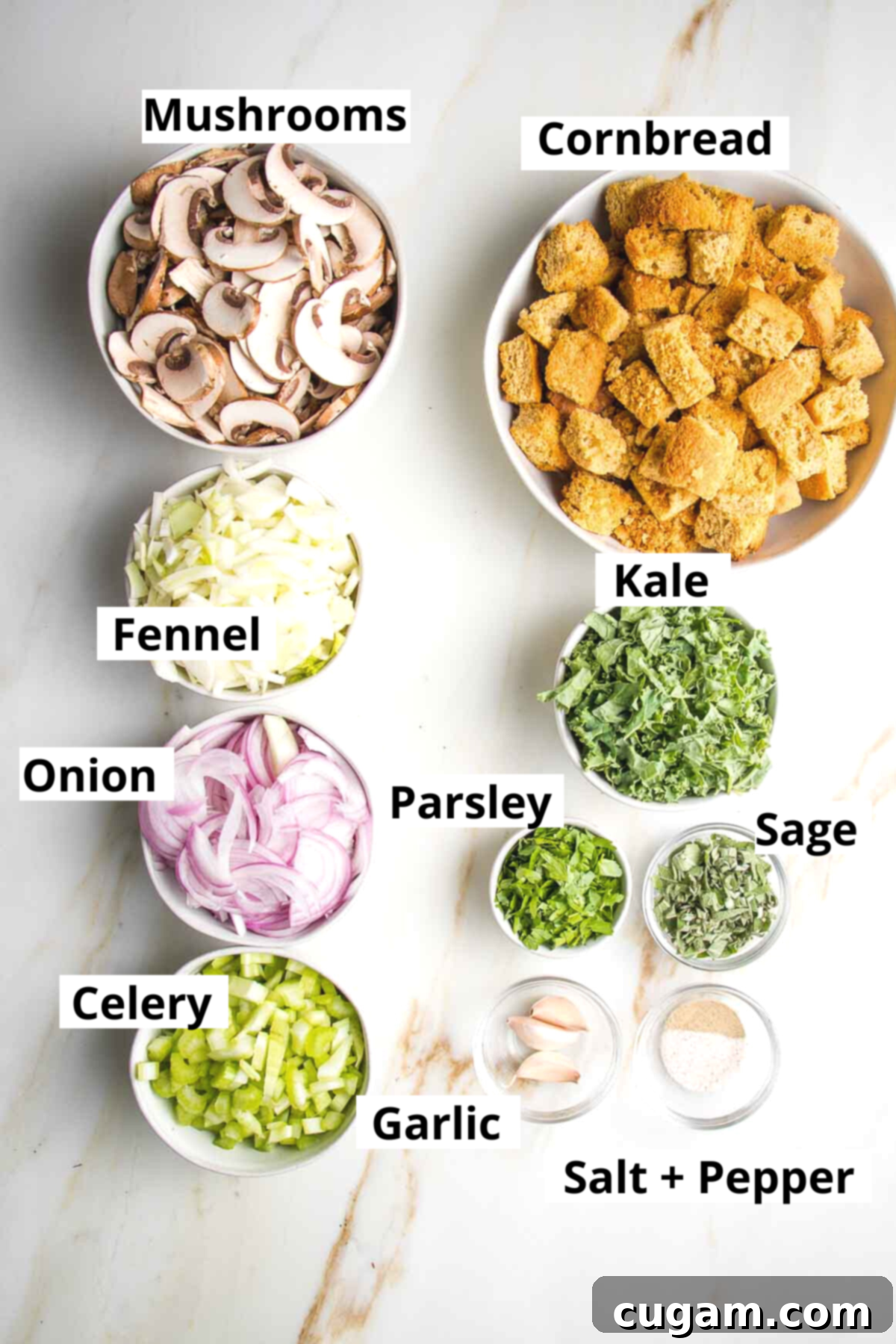
- Cornbread: The foundation of any great cornbread stuffing. For the best gluten-free and vegan experience, I highly recommend using my homemade vegan and gluten-free cornbread recipe. Its tender crumb and rich flavor are perfectly suited for absorbing all the delicious savory liquids and aromatics. Aim for slightly stale or dried cornbread cubes for optimal texture, which we’ll discuss further below.
- Mushrooms: These fungi are crucial for imparting a deep, earthy, and irresistible vegan umami flavor to the stuffing. While any variety works, I particularly enjoy using thinly sliced baby bella (cremini) mushrooms. They shrink beautifully when cooked, adding a delightful textural component to the finished dish. If mushrooms aren’t to your liking, a fantastic substitute to achieve that savory depth is to whisk 1 tablespoon of white miso paste into your vegetable broth before adding it to the stuffing mixture. This ensures no flavor is lost!
- Fennel: Don’t shy away from fennel! Its unique, subtle anise flavor transforms into a savory sweetness when cooked, adding an unexpected layer of complexity to the stuffing. Remember to save the delicate fronds – they make a beautiful and aromatic garnish for the finished dish. If you opt to skip the fennel, simply increase the amount of celery to maintain a similar textural presence.
- Celery: Providing essential crunch and a classic aromatic base, celery is a stuffing staple. If your celery stalks come with leafy tops, by all means, include them for extra flavor and visual appeal! In a pinch, if you don’t have fresh celery, you can mimic its flavor by adding 1 teaspoon of celery seed along with your salt and pepper. For bulk, consider substituting with finely diced yellow or red bell peppers, or even a chopped green apple for a touch of tartness. Thinly sliced bok choy (including the green parts) or simply doubling the fennel can also serve as excellent alternatives.
- Onion: Onions are fundamental to building the savory backbone of any good stuffing. I personally prefer the subtle sweetness and beautiful color that purple (red) onions contribute, but yellow or white onions will work just as well. For a more gourmet touch, finely diced shallots or thinly sliced leeks are excellent and equally delicious substitutions, offering their own distinct aromatic qualities.
- Sage: This herb is synonymous with Thanksgiving flavors. Fresh sage provides an unparalleled aromatic depth. If fresh sage isn’t available, you can substitute with dried sage, using a ratio of 2 teaspoons dried for every 2 tablespoons of fresh. Remember that dried herbs are more concentrated, so adjust accordingly.
- Parsley: Fresh chopped parsley brightens the entire dish with its vibrant, herbaceous notes. It adds both flavor and a pop of color. Should you need an alternative, fresh oregano or thyme can provide a similar aromatic quality, though with a slightly different flavor profile.
- Kale: My philosophy is, why not add more nutrient-dense vegetables? Kale is a fantastic addition, bringing extra nutrition, a lovely texture, and beautiful color. It pairs wonderfully with mushrooms and wilts down perfectly into the stuffing mixture, making it a healthy and visually appealing component.
- Garlic: Essential for any savory dish, garlic adds a pungent and aromatic kick. The recipe calls for 3 cloves, but if you’re a garlic lover, feel free to add more – you truly can’t have too much! Ensure it’s minced or pressed for even distribution of flavor.
- Salt & Pepper: These fundamental seasonings bring all the flavors to life. I prefer the subtle, slightly smoky heat of white pepper in this stuffing, but freshly ground black pepper is an equally excellent choice and will deliver a robust flavor. Always taste and adjust seasonings to your preference before the final bake.
The Essential Step: How to Properly Dry Cornbread for the Best Stuffing
Achieving the perfect texture in your cornbread stuffing starts with one critical step: properly drying your cornbread. The best gluten-free cornbread stuffing begins with homemade cornbread, as it allows you to control the ingredients and achieve the ideal crumb. Once your cornbread is baked, the goal is to transform it into absorbent “croutons” that will soak up all the flavorful vegetable broth without becoming mushy.
Ideally, you should bake your cornbread a few days in advance. After it has cooled completely, cut it into uniform 1-inch cubes. Spread these cubes in a single layer on a large baking sheet and leave them uncovered at room temperature overnight. This allows natural air circulation to begin the drying process, making them firm and ready for the next step.
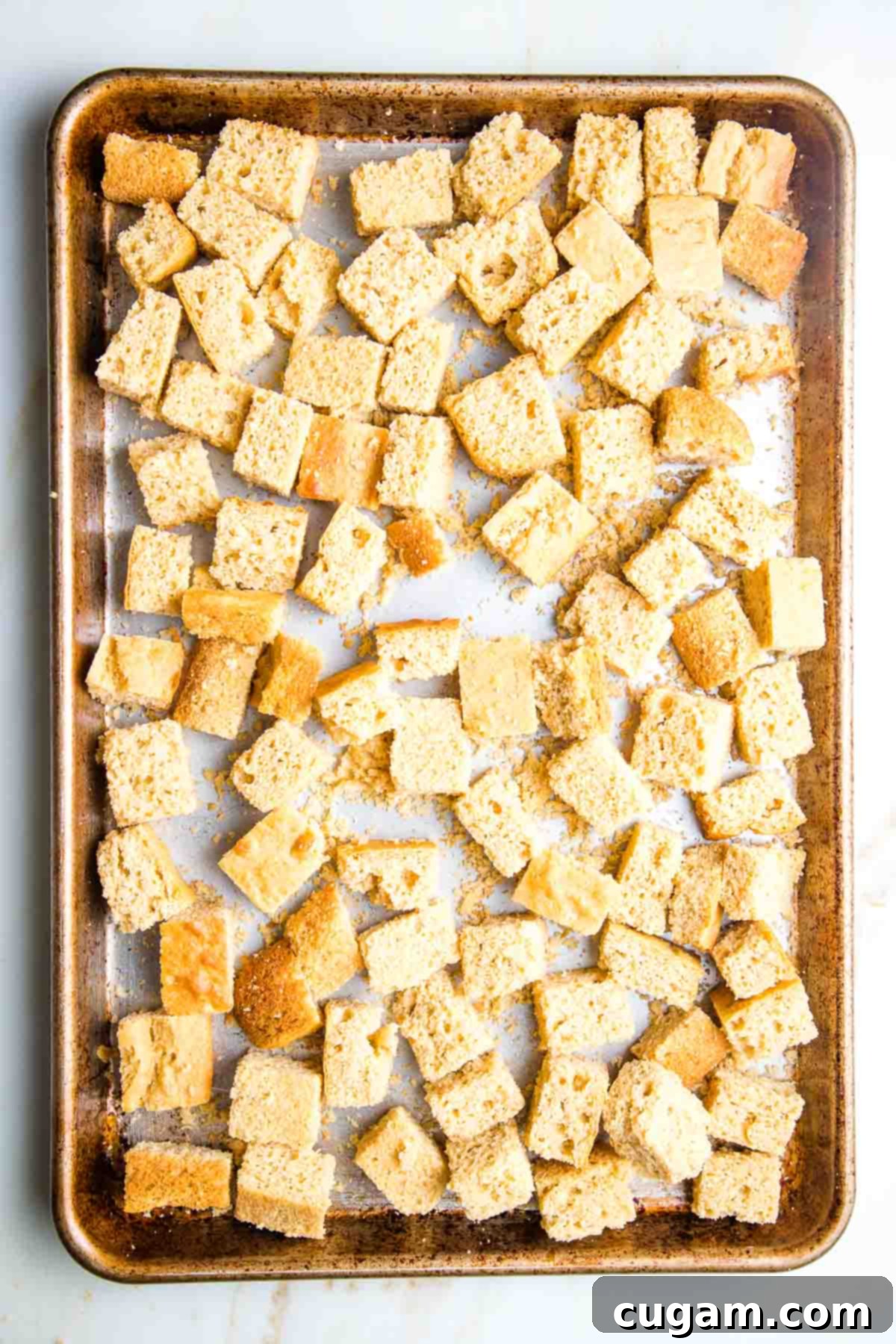
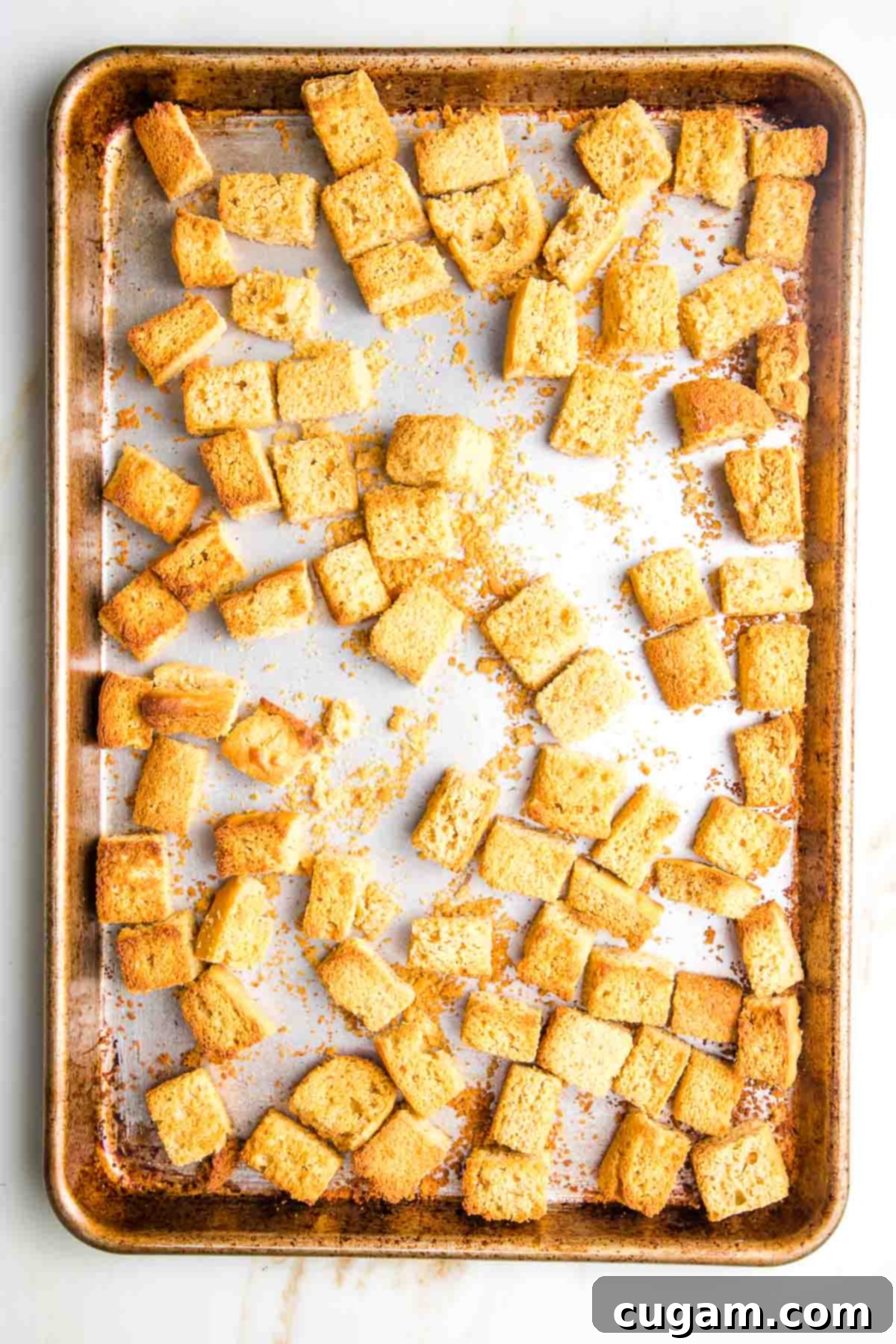
From personal experience, I can tell you that even after sitting out overnight, my cornbread cubes often still need a little help. (And yes, a few might mysteriously disappear in my kitchen, a common occurrence I’m sure many of you can relate to!). For truly dry and slightly crisp cornbread croutons, which are essential for stuffing that holds its texture, I recommend popping them into a 350°F (175°C) oven for about 20-25 minutes. This gentle toasting process transforms them, creating a desirable crouton-like texture on the outside while keeping them ready to absorb moisture within.
PRO TIP: When preparing your cornbread croutons, don’t worry about perfect cubes or discarding any smaller pieces. In fact, include all the crumbs and irregular bits. These varying textures are key to a truly great stuffing, adding delightful complexity and ensuring every bite is interesting.
Mastering Fennel: A Simple Guide to Prepping This Flavorful Ingredient
If you’re new to cooking with fennel, don’t let its unique appearance deter you! This often-underestimated vegetable is incredibly delicious and adds a complex, aromatic dimension to dishes, especially to this vegan cornbread stuffing. When cooked, fennel’s distinct licorice-like flavor mellows beautifully, transforming into a sweet, caramelized essence that is absolutely divine. It’s a key player in achieving the unique taste profile of this stuffing, so let’s learn how to prep it like a pro.
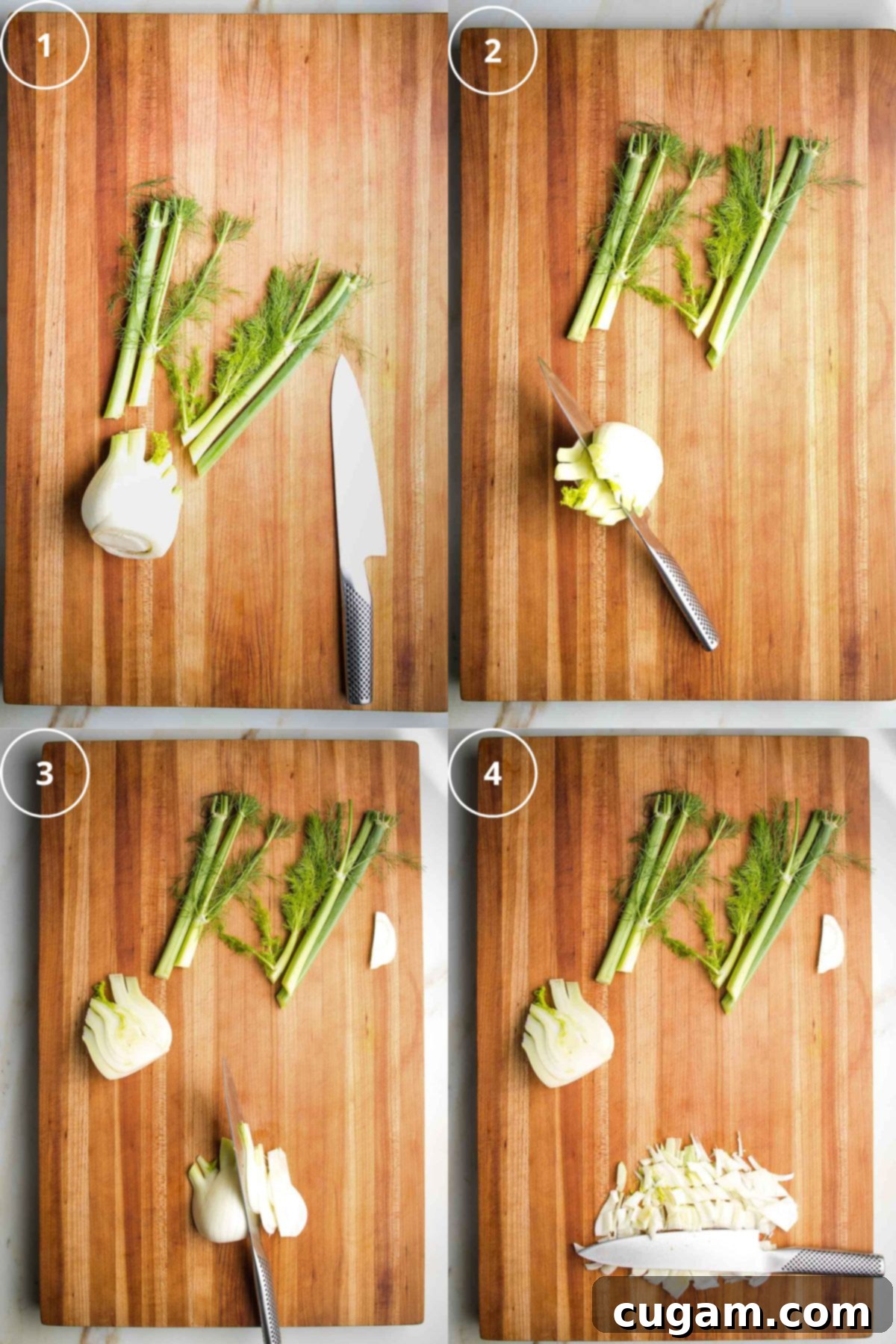
- Remove the Fronds: Begin by carefully cutting off the delicate, feathery green fronds from the top of the fennel bulb. These are not only edible but also highly aromatic. Set them aside, as they make a stunning and flavorful garnish for your finished stuffing, adding a touch of elegance.
- Stabilize and Halve: Next, stand the fennel bulb upright on its flat bottom. If it’s a bit wobbly, you can trim a small sliver off the very bottom to create a stable base. Then, carefully slice the bulb in half right down through its center, from top to bottom.
- Slice into Strips: Place one of the fennel halves flat-side down on your cutting board. Using a sharp knife, cut it into thin, even strips. The thinner the strips, the quicker they will cook and caramelize.
- Dice into Cubes: Finally, gather your strips and cut across them in the opposite direction, creating small, uniform cubes. Repeat this process with the remaining half of the fennel bulb. This precise dicing ensures even cooking and distribution of flavor throughout your stuffing.
Crafting Your Delicious Gluten-Free Cornbread Stuffing: Step-by-Step
Now that your cornbread is perfectly dried and your vegetables are prepped, it’s time to bring all the flavors together to create this incredible gluten-free vegan stuffing. The cooking process is straightforward, focusing on developing rich flavors at each stage.
Sautéing the Aromatic Vegetables
Begin by heating a heavy skillet (a cast iron pan works exceptionally well for even heat distribution) over medium heat. Once hot, swirl in your olive oil. While olive oil is preferred for flavor, water or vegetable broth can be used for an oil-free alternative. Add the sliced mushrooms, onions, diced celery, and chopped fennel to the skillet. Allow these robust vegetables to sauté, stirring occasionally, for about 10-15 minutes. During this time, they will soften considerably and begin to caramelize, developing a wonderful depth of flavor that is essential for the stuffing.
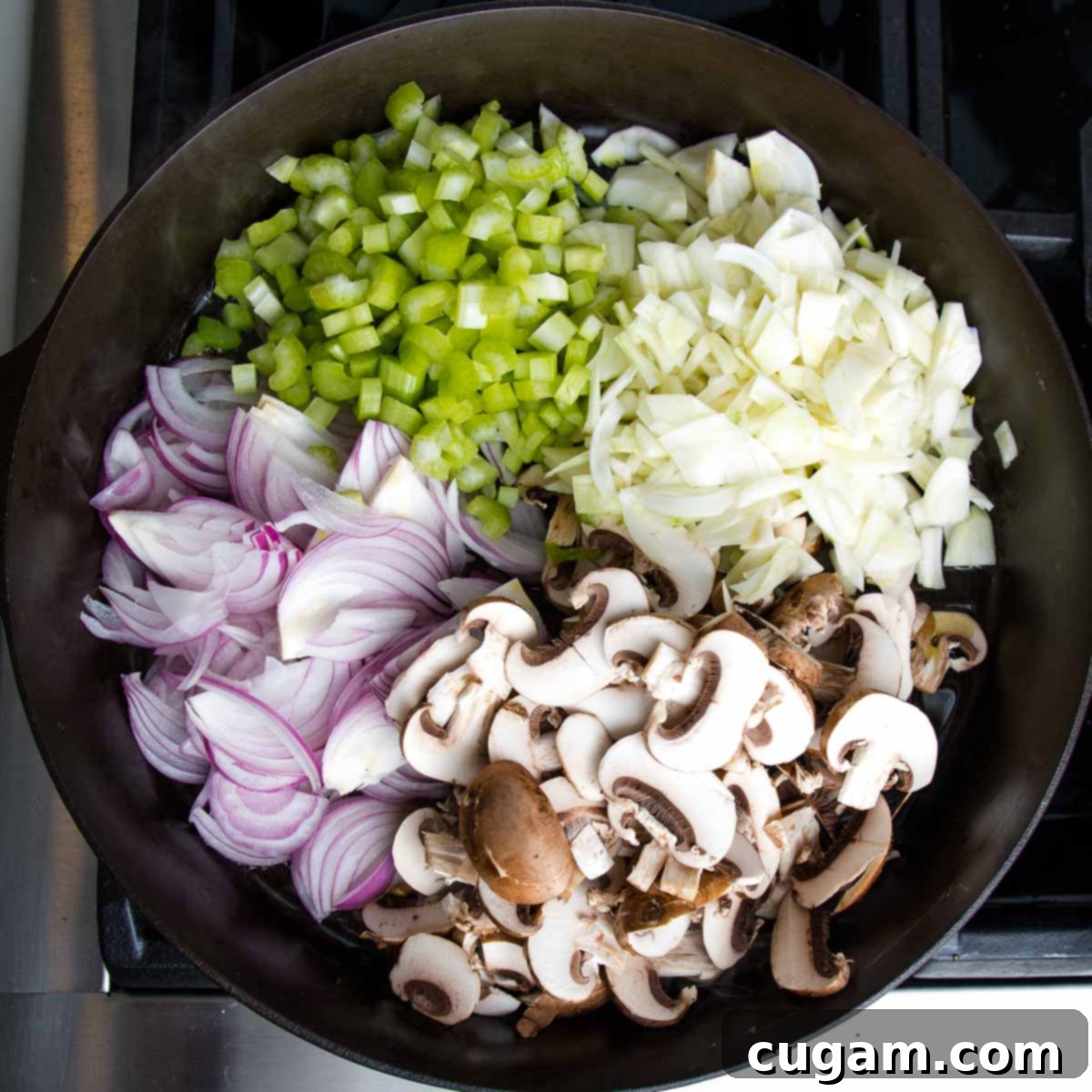
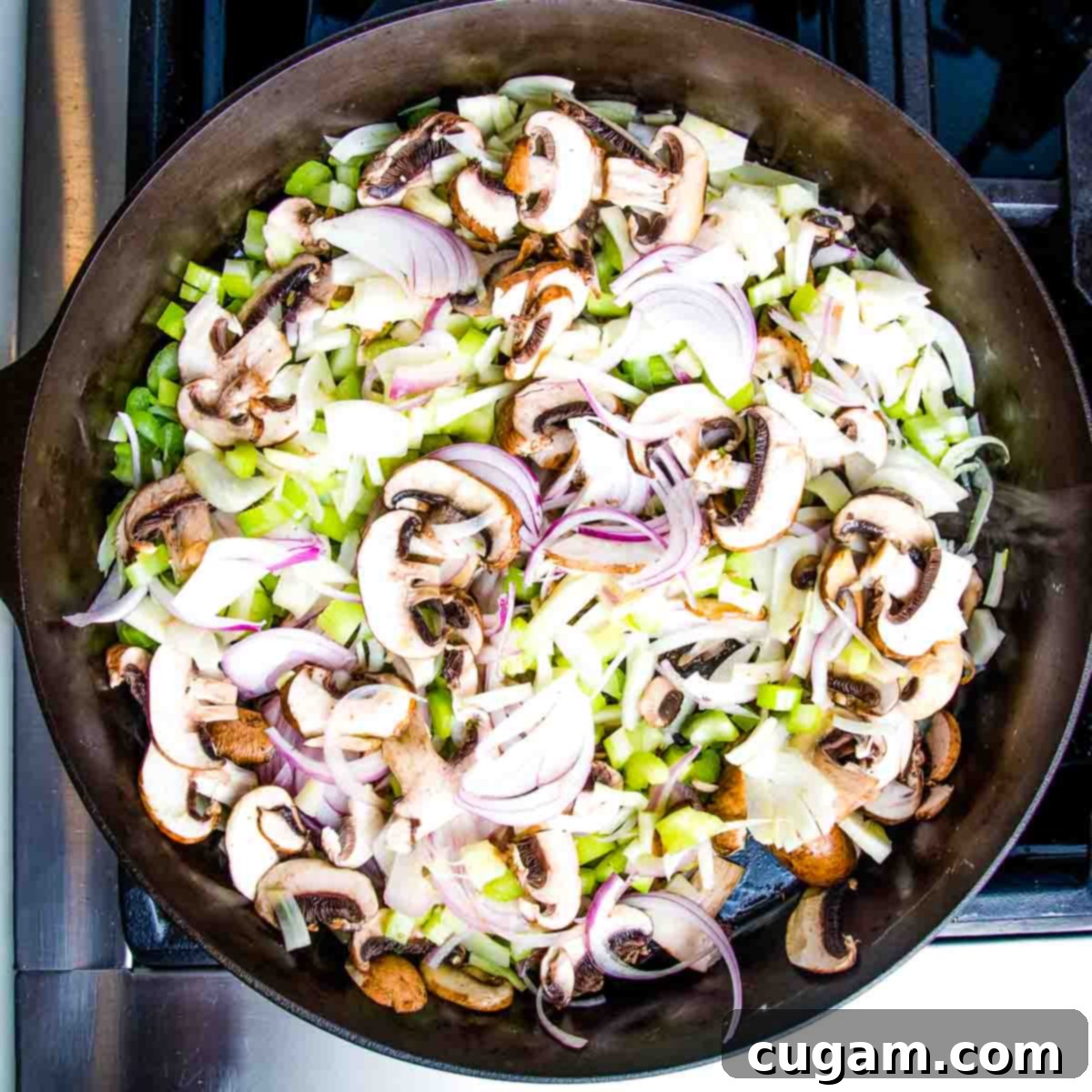
Once the vegetables are tender and slightly golden, stir in your salt and pepper, followed by the minced garlic. Continue to cook for another 2-3 minutes, stirring constantly, until the garlic becomes wonderfully fragrant. Be careful not to burn the garlic, as this can turn bitter. If the pan seems too dry at any point, add a tablespoon of vegetable stock to deglaze and prevent sticking.
Remove the skillet from the heat. Now, it’s time to incorporate the fresh greens and herbs. Add the chopped kale, fresh sage, and fresh parsley to the warm vegetable mixture. Stir everything together thoroughly, allowing the residual heat from the pan to gently wilt the kale and release the aromatic oils from the herbs. This step ensures the fresh flavors are well-distributed throughout the stuffing base.
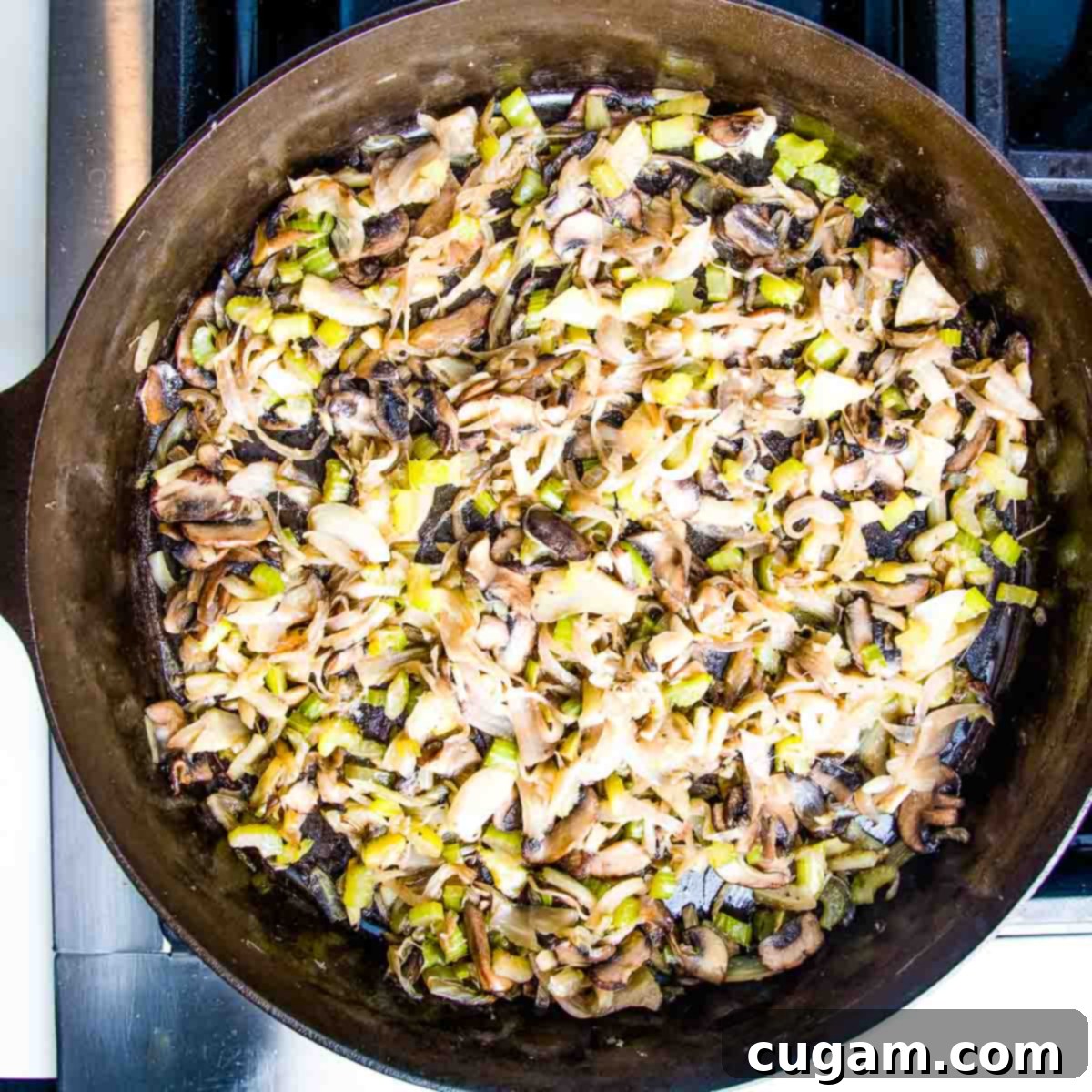
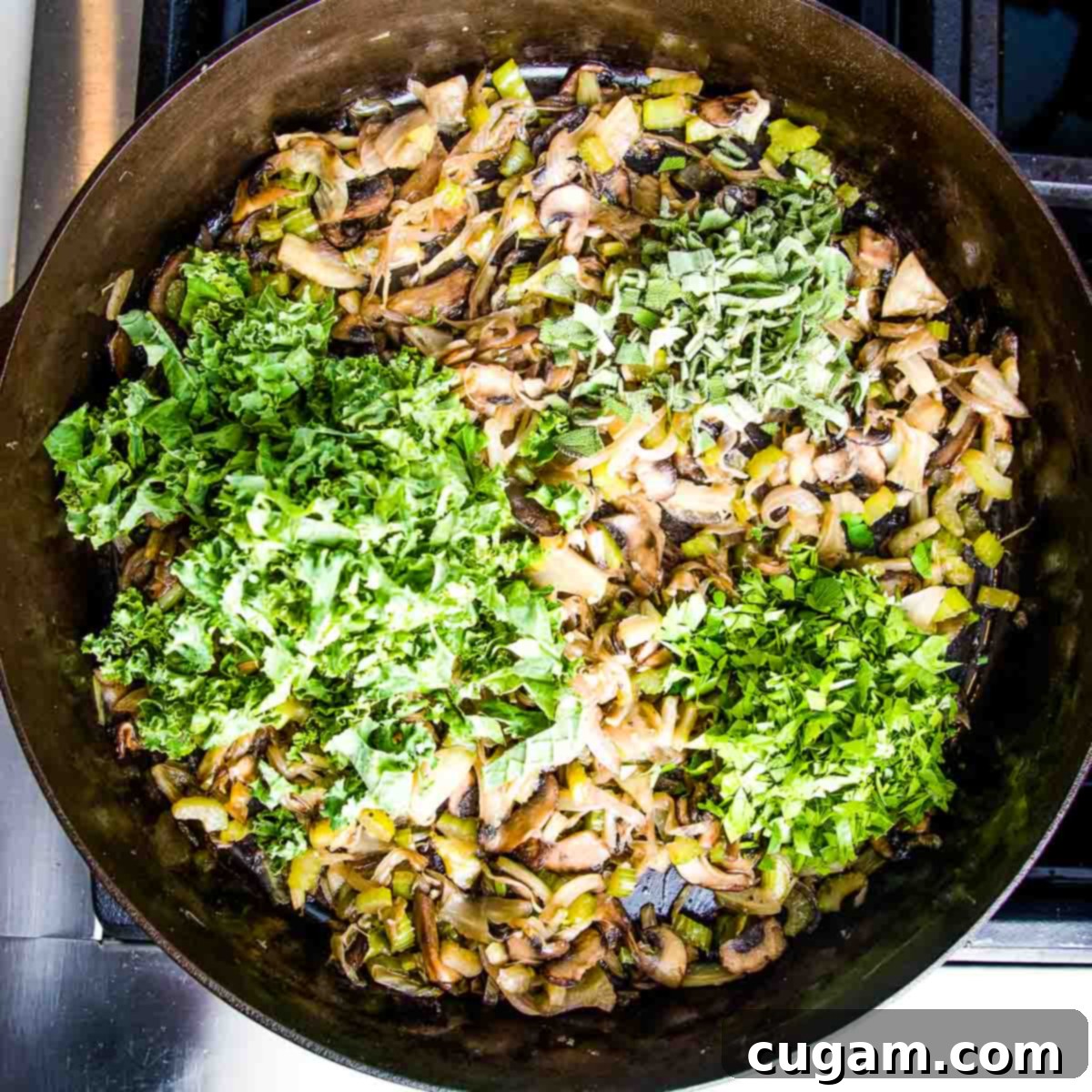
Combining and Baking for Perfection
Transfer the fragrant sautéed vegetable and herb mixture into a large mixing bowl, joining forces with your prepared cornbread croutons and any delicious crumbs. Gently mix everything together until the vegetables are evenly distributed among the cornbread pieces. Be careful not to overmix, as you want to maintain some structure in the cornbread.
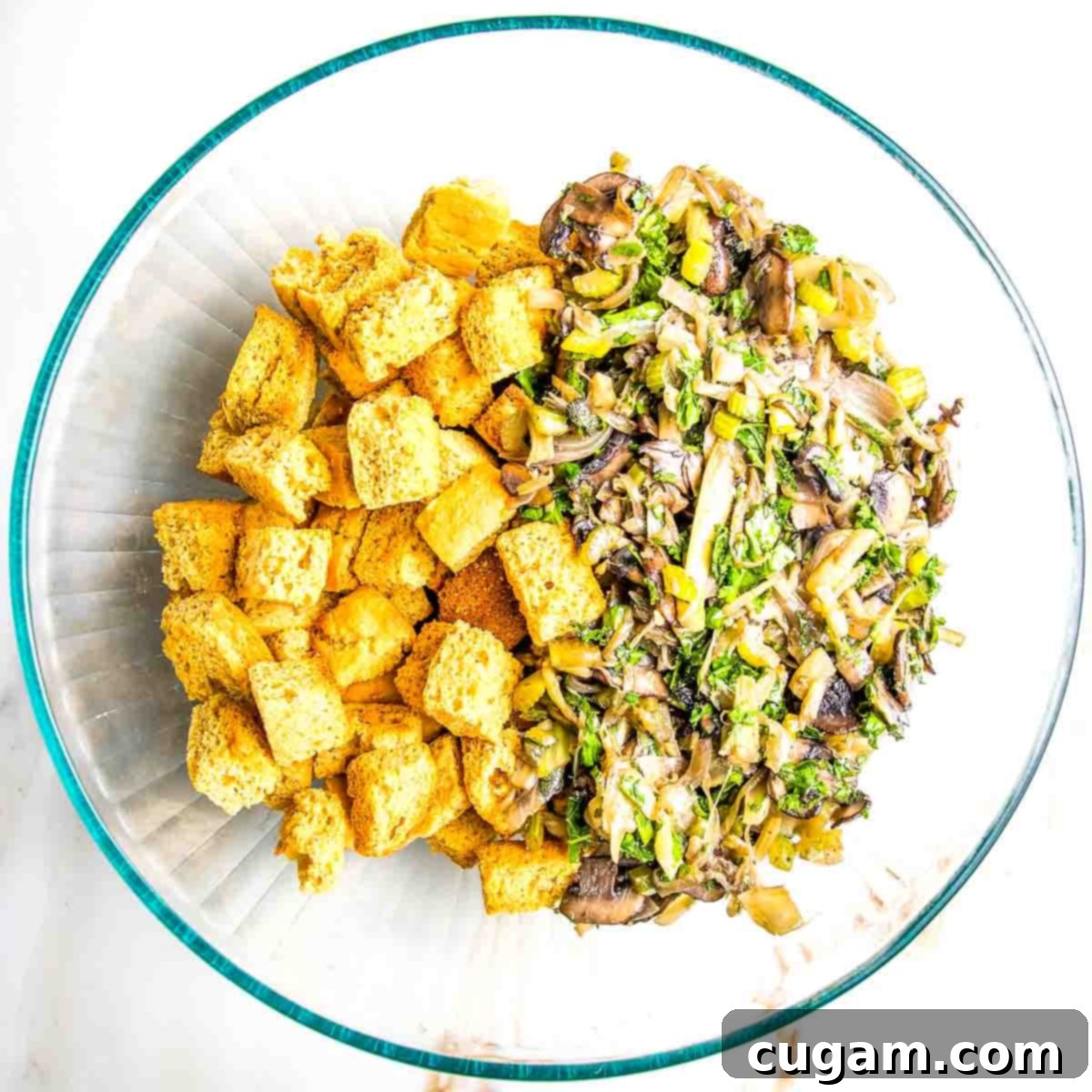
Once thoroughly combined, pour the stuffing mixture into a 9×13 inch baking dish and spread it out evenly. This uniform layer is important for consistent cooking. Next, generously pour vegetable stock over the entire mixture. This is where the magic happens: the dried cornbread will eagerly soak up the flavorful broth, ensuring the bottom of your stuffing remains wonderfully soft and moist, while the top, exposed to direct heat, will develop that irresistible golden-brown crispness that everyone loves.
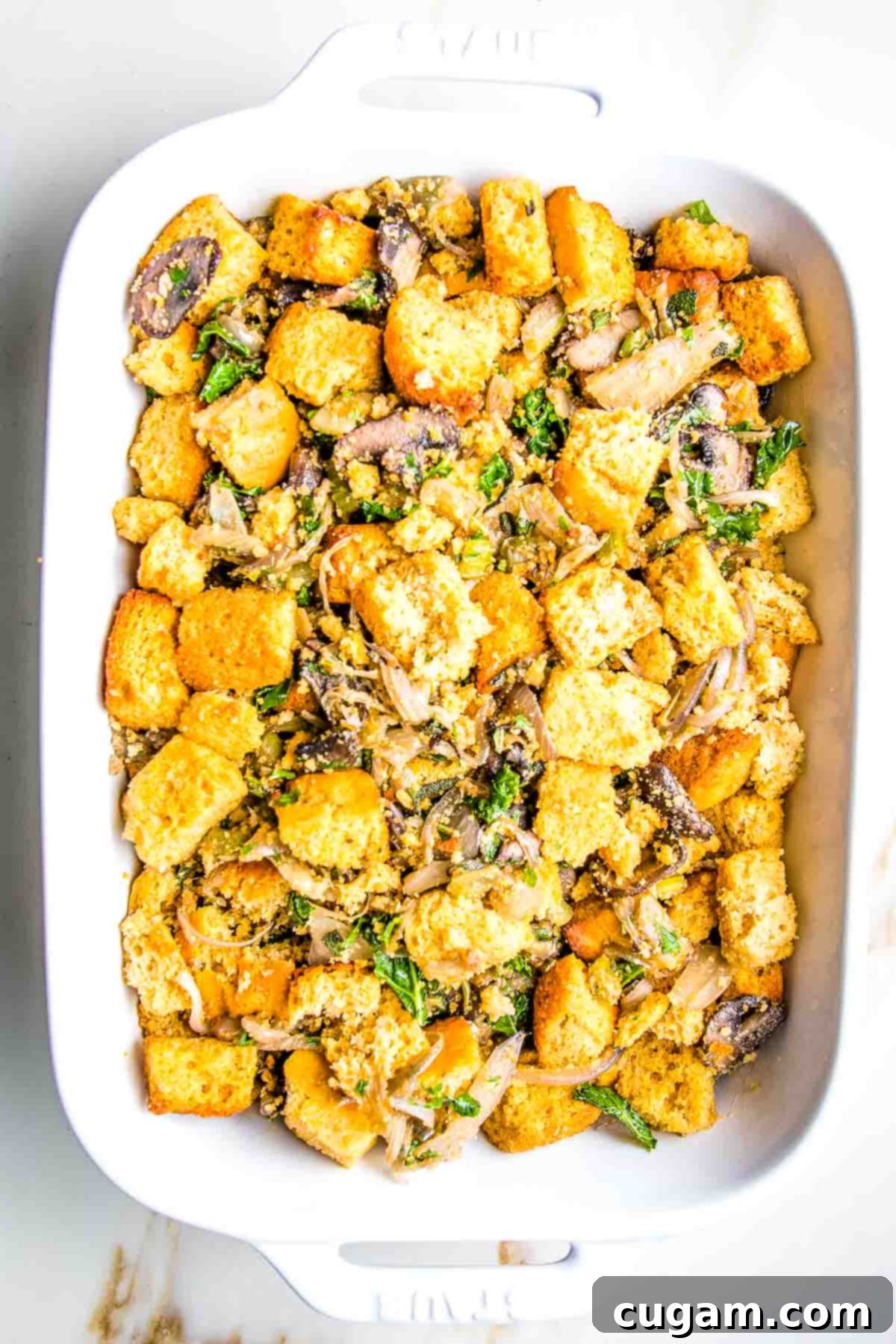
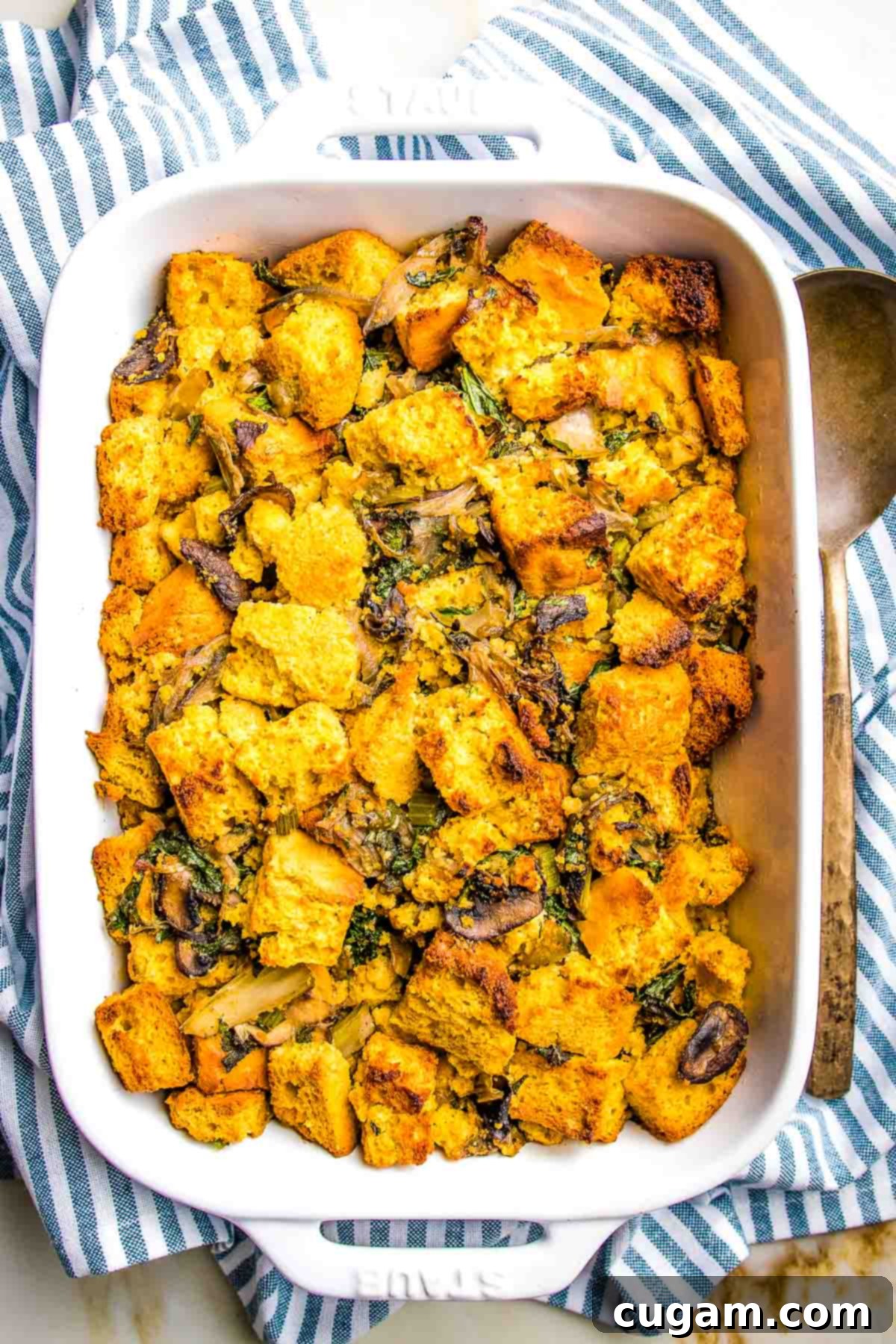
Cover the baking dish tightly with aluminum foil. This traps moisture and ensures the stuffing cooks through without drying out. Bake for 25-30 minutes. After this initial bake, remove the foil and return the stuffing to the oven for an additional 15 minutes. This final uncovered baking period allows the top to crisp up beautifully and achieve that coveted golden-brown finish. Once baked to perfection, remove from the oven and let it rest for a few minutes before serving. Garnish with fresh fennel fronds or parsley, if desired.
Debra’s Pro Tips for the Perfect Gluten-Free Vegan Stuffing
Here are some additional insights and pro tips to help you achieve the absolute best gluten-free cornbread stuffing for your holiday table, making your cooking experience smoother and the results even more delicious.
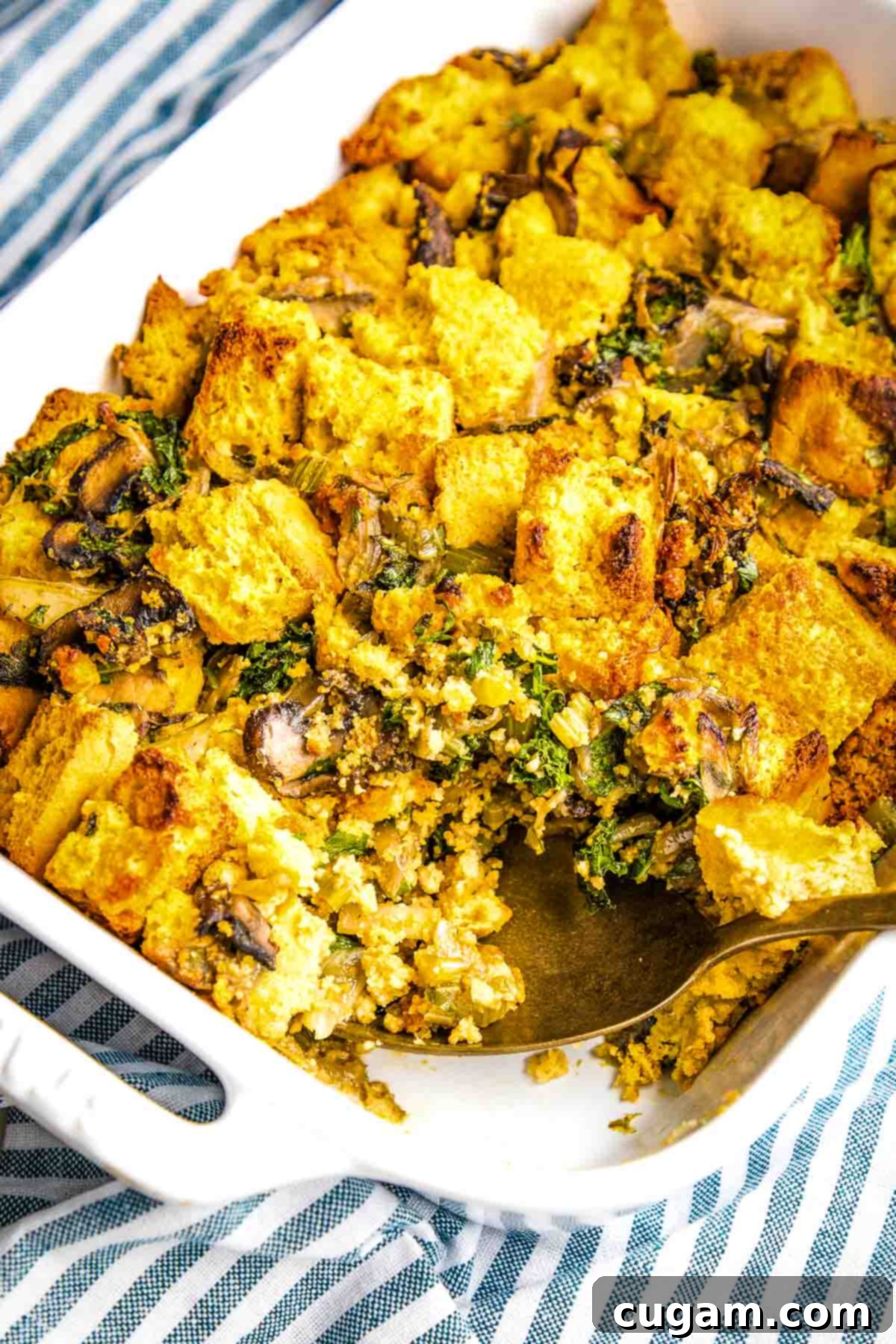
- Don’t Skip the Drying Step: As emphasized earlier, the step of drying out your cornbread cubes is non-negotiable for a stuffing with excellent texture. This prevents a soggy outcome and allows the cornbread to properly absorb the flavorful broth, resulting in that desirable soft interior and crispy exterior.
- Strategic Make-Ahead Prep: For a stress-free Thanksgiving, plan ahead! You can prepare the cornbread croutons up to a month in advance. Simply toast them, allow them to cool completely, then freeze them in an airtight container or freezer bag. Thaw to room temperature before assembling the stuffing. This simple step significantly reduces your workload during the busy holiday week.
- Achieve the Perfect Crisp: The baking method, starting covered and finishing uncovered, is crucial. Covering the dish ensures the stuffing steams and remains moist internally. Removing the foil for the final 15-20 minutes allows the top layer to brown beautifully and become delightfully crispy, offering a wonderful contrast to the tender interior. Keep an eye on it to prevent over-browning.
- Adjust Moisture to Your Liking: The recipe calls for 2 cups of vegetable stock, which yields a perfectly moist stuffing with a crisp top. However, if you prefer an even wetter, more “dressing-like” consistency, feel free to increase the vegetable stock to 3 cups. Taste preferences vary, so adjust to your family’s favorite!
- Experiment with Herbs: While sage and parsley are traditional, don’t hesitate to experiment with other fresh herbs. Thyme, rosemary, or a touch of marjoram can add delightful new nuances to your stuffing. Fresh herbs always make a difference compared to dried ones.
- Consider a Gluten-Free Bread Alternative: If cornbread isn’t your preference, this recipe can also be adapted with other types of gluten-free bread. Just ensure it’s equally dried out to prevent mushiness.
More Healthy Thanksgiving Recipes
- Mashed Acorn Squash Recipe
- Easy Vegan Gravy Recipe
- The Best Vegan Dinner Rolls
- Easy Recipe for Green Beans with Almonds
Did you know commenting and rating recipes is one of the best ways to support your favorite food bloggers? If you made this recipe, please consider giving it a five-star rating below and leave a comment to share your experience. Also, we’d love to see your culinary creations! Please share your photos on Instagram by tagging me @dkhealthcoach and using the hashtag #debraklein. Your feedback and shares truly help our community grow!
📖 Recipe
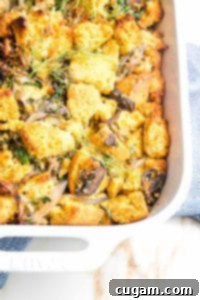
Cornbread Stuffing
Rate this Recipe
Pin Recipe
Equipment
-
Extra Large Bamboo Cutting Board
-
Global 8″ Chef’s Knife
-
Cast iron skillet
-
13 inch Baking dish
-
Large Rimmed Baking Sheet
Ingredients
- 8 cups cubed vegan cornbread
- 2 Tablespoons olive oil
- 8 oz. mushrooms* sliced thin
- 1 large purple onion sliced thin
- 1 bulb fennel chopped
- 3 stalks celery diced
- 3 cloves garlic minced or pressed
- 1 cup chopped curly kale
- ¼ cup chopped fresh parsley
- 2 Tablespoons chopped fresh sage
- 1 teaspoon sea salt
- ½ teaspoon white pepper
- 2 cups vegetable stock
Instructions
-
Preheat oven to 350°F (175°C).
-
Turn cornbread into croutons. Essentially, you want to dry it out. It’s easiest if your cornbread is a few days old. You can cut it into cubes and leave on a baking tray in a single layer to dry overnight at room temperature. If they’re not crumbly yet, or if you have just made the cornbread, you can bake them on a baking tray in a single layer at 350°F (175°C) for 20-25 minutes until dry and slightly crisp. Place cubes, plus any crumbs, in a large bowl.
-
Turn oven up to 400°F (200°C) after removing the cornbread croutons.
-
Heat a heavy skillet over medium heat. Swirl in olive oil and then add mushrooms, onions, fennel, and celery. Cook, stirring occasionally, for 10-15 minutes, as veggies soften and begin to caramelize. Add in salt, pepper, and minced garlic. Continue to cook for another 2-3 minutes, stirring, until the garlic becomes fragrant and the veggies are perfectly tender. If the pan becomes too dry, add in 1 Tablespoon of veggie stock at a time, as needed, to deglaze.
-
Turn off heat and stir in the chopped kale, fresh parsley, and fresh sage. Stir well and continue to stir until the kale is wilted and thoroughly incorporated into the mixture.
-
Add the sautéed veggie mixture to the large bowl with the cornbread croutons and mix well until everything is evenly combined.
-
Pour the cornbread/veggie mixture into a 9 x 13 inch baking pan and spread evenly. Pour 2 cups of vegetable stock over the mixture. Cover the baking dish tightly with aluminum foil. Bake covered for 25-30 minutes. Then, remove the foil and bake for an additional 15-20 minutes, or until the top is golden brown and crispy.
Video
Notes
Mushrooms: While I used baby bella mushrooms for their robust flavor, feel free to use any mushroom variety or a combination, such as crimini, oyster, shiitake, or white button mushrooms. If you or your guests prefer to omit mushrooms, achieve a similar umami depth by adding 1 tablespoon of white miso paste to the vegetable broth and whisking it thoroughly before pouring over the stuffing.
Fennel: Don’t skip this unique ingredient! Refer to the “How to Cut Fennel” section above for a visual guide. Remember to reserve some of the delicate fennel fronds to use as a beautiful and aromatic garnish for your baked stuffing. If fennel is unavailable or not preferred, compensate by adding an extra stalk of celery and using a slightly larger onion to maintain volume and a balanced aromatic base.
Vegetable Broth: The recipe suggests 2 cups of vegetable stock for a moist interior and crisp top. For an even more moist, softer stuffing, increase the vegetable stock to 3 cups. I highly recommend making homemade vegetable stock to control sodium levels and flavor, especially if you’re using store-bought broth which often contains added salt. Adjust your added salt accordingly.
Batch Size: This recipe is easily adaptable! You can effortlessly halve the ingredients for a smaller gathering, or even reduce it to one-third if you only need a small amount of this delicious gluten-free vegan cornbread stuffing.
Nutrition
Note
The nutrition calculations were done using online tools. To obtain the most accurate representation of the nutritional information in any given recipe, you should calculate the nutritional information with the actual ingredients you used. You are ultimately responsible for ensuring that any nutritional information is accurate, complete and useful.
